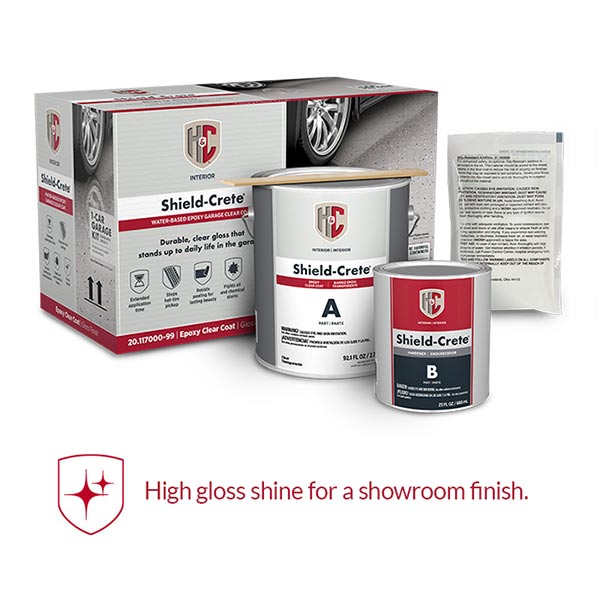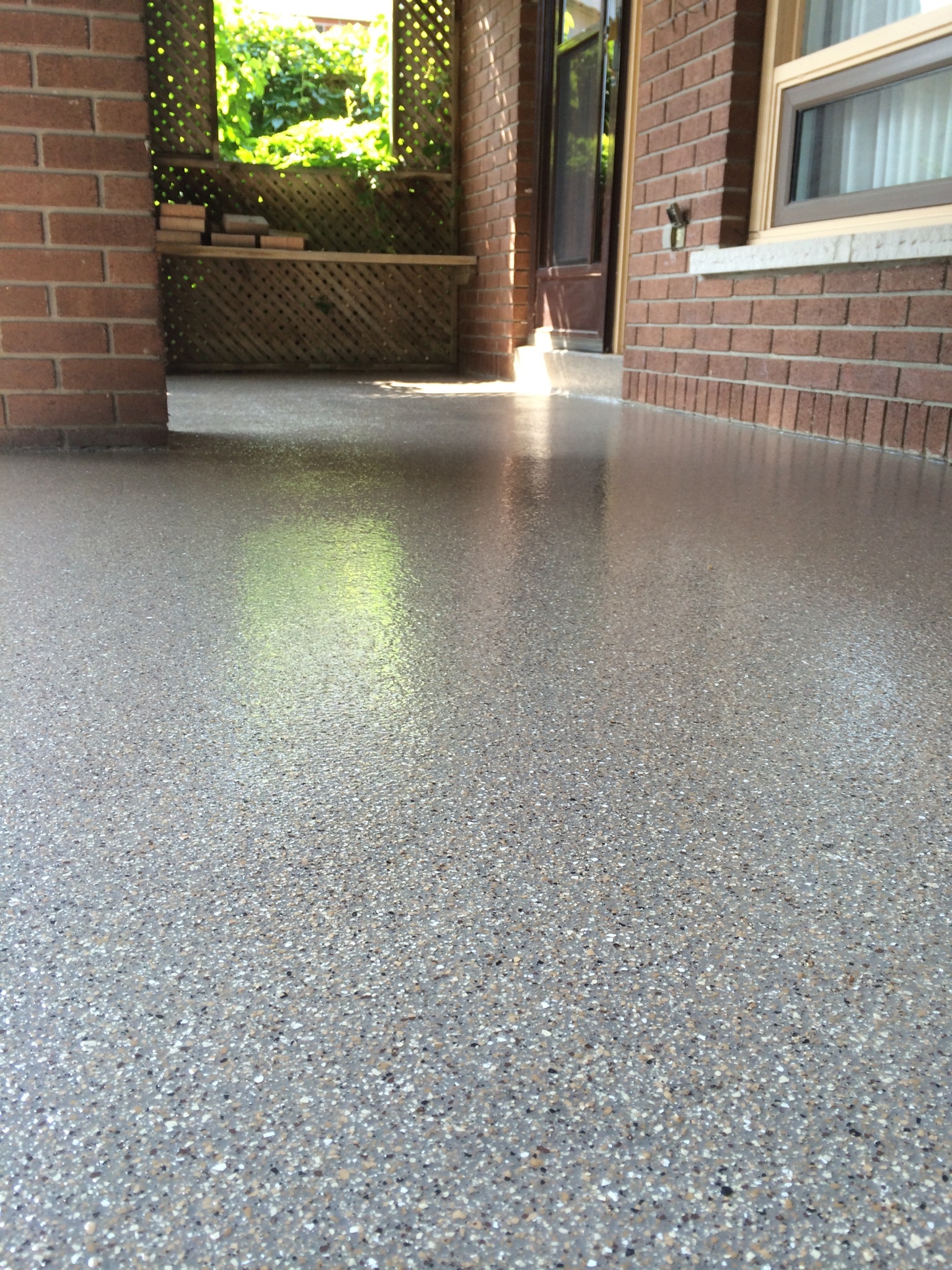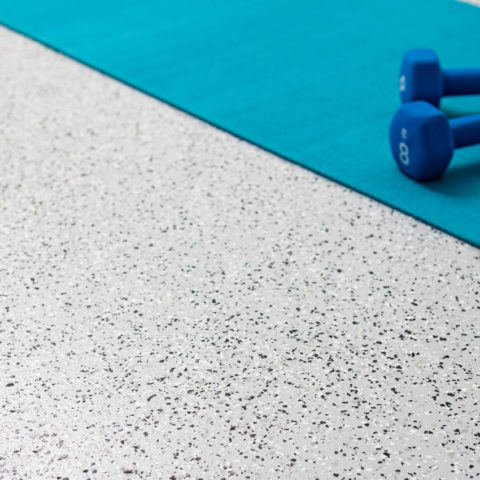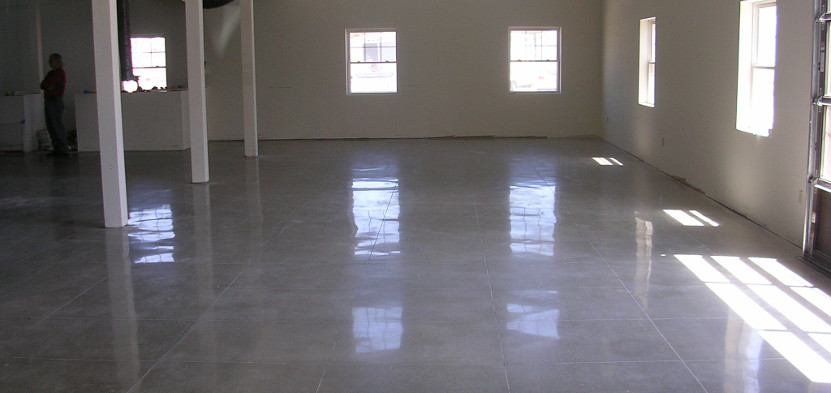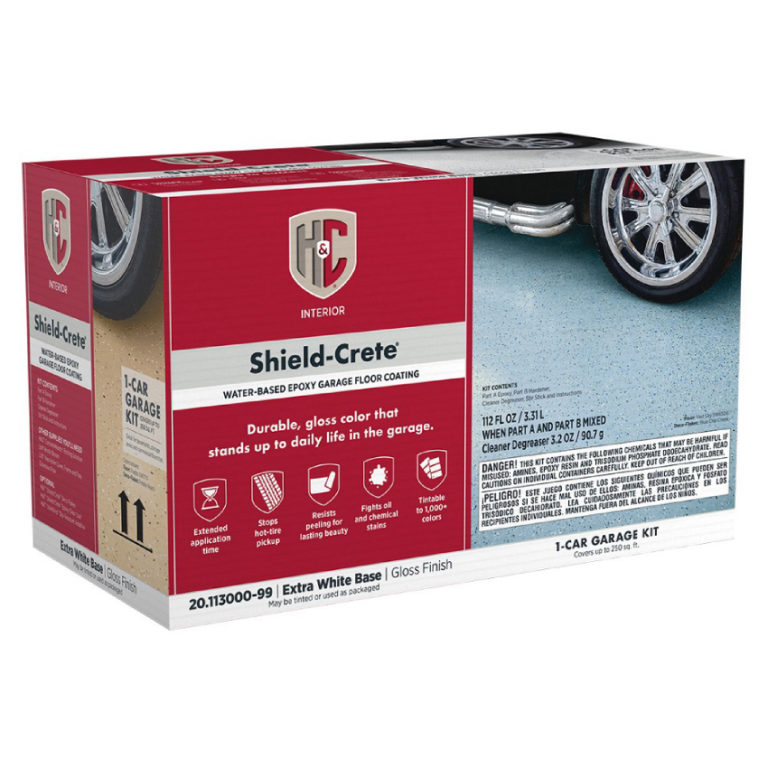Epoxy coating for concrete floors is a popular choice for both residential and commercial spaces due to its durability, aesthetic appeal, and versatility. Whether you’re looking to enhance your garage, basement, or industrial workspace, epoxy coatings offer a seamless, easy-to-clean surface that stands up to heavy use. Let me walk you through everything you need to know about epoxy coatings for concrete floors, from preparation and application to maintenance and troubleshooting. I’ll also highlight common mistakes to avoid and answer frequently asked questions to help you achieve the best results.
What Are They and Why Choose Them?
Epoxy coatings are a type of resin that, when mixed with a hardener, creates a strong, adhesive bond to the concrete surface. The result is a durable, glossy finish that not only protects the concrete but also enhances its appearance. One of the main reasons people choose epoxy coatings is for their resilience. They are resistant to stains, chemicals, and abrasions, making them ideal for high-traffic areas.
The durability of epoxy coatings is one of their standout features. Once cured, epoxy forms a tough, hard surface that can withstand heavy machinery, foot traffic, and even vehicle use without showing signs of wear. This makes it a popular choice for garages, warehouses, and industrial spaces. Additionally, epoxy is resistant to most chemicals, including oil, gasoline, and many cleaning agents, making it easy to maintain.
Another significant advantage of epoxy coatings is their aesthetic versatility. Epoxy comes in a variety of colors and finishes, from solid colors to metallic effects and even custom patterns. This allows you to tailor the look of your floor to suit your personal taste or brand identity. Decorative chips or flakes can also be added to the epoxy mix to create a textured, non-slip surface, which is both practical and visually appealing.
Epoxy coatings also have the benefit of being seamless and non-porous. This means that once applied, there are no cracks or gaps where dirt and moisture can accumulate. This makes epoxy floors incredibly easy to clean and maintain. Spills can be wiped up easily, and regular sweeping and mopping will keep the floor looking pristine.
When it comes to safety, epoxy coatings can be formulated to include anti-slip additives, which are especially important in environments where the floor might become wet or oily. These additives help to create a safer working or living environment by reducing the risk of slips and falls.
Last, epoxy coatings are environmentally friendly. They are made from materials that are low in VOCs (volatile organic compounds), which means they don’t release harmful chemicals into the air during application or over time. This makes them a safer option for indoor use, particularly in homes or spaces where air quality is a concern.

Preparing Your Concrete Floor: Essential Steps Before Application
Before applying an epoxy coating, it’s crucial to properly prepare your concrete floor. This step is essential for ensuring that the epoxy adheres well to the surface and provides a long-lasting finish. Preparation involves cleaning, repairing, and possibly etching the concrete to create the ideal surface for the epoxy to bond with.
The first step in preparation is cleaning the concrete surface thoroughly. Dirt, dust, grease, and other contaminants can prevent the epoxy from adhering properly. Start by sweeping the floor to remove loose debris, then use a heavy-duty degreaser or cleaner to remove any oil stains or grease. It’s important to rinse the floor thoroughly and allow it to dry completely before proceeding to the next step.
After cleaning, inspect the concrete for any cracks, chips, or other damage. These imperfections should be repaired before applying the epoxy. Use a concrete patching compound to fill in cracks and holes, smoothing the surface as much as possible. This ensures that the epoxy coating will have a smooth, even surface to adhere to, which is crucial for a professional-looking finish.
Etching the concrete is often recommended, especially if the surface is very smooth. Etching opens up the pores of the concrete, allowing the epoxy to penetrate and bond more effectively. You can use a commercial concrete etcher or a diluted acid solution for this purpose. Apply the etching solution evenly across the floor, following the manufacturer’s instructions, and then rinse thoroughly to remove any residue.
Once the floor is clean, repaired, and etched, it’s time to check the moisture levels in the concrete. High moisture content can prevent the epoxy from curing properly, leading to a weak bond and potential failure of the coating. Use a moisture test kit to check the levels, and if necessary, allow the concrete to dry out or apply a moisture barrier before proceeding.
Masking off areas where you don’t want the epoxy to go is another important step in the preparation process. Use painter’s tape to protect walls, baseboards, and any fixtures that are close to the floor. This will help you achieve clean, sharp edges and prevent any accidental spills from marring your final result.
Finally, before you begin applying the epoxy, make sure the room is well-ventilated. Epoxy coatings can emit strong fumes during the application process, so open windows and doors, and consider using fans to improve airflow. Wearing protective gear, including gloves, safety glasses, and a respirator, is also recommended to protect yourself from any potential exposure to chemicals.
The Application Process: How to Apply Epoxy Coating to Concrete Floors
Applying an epoxy coating to concrete floors involves several steps, each of which must be executed carefully to achieve a durable, professional-looking finish. From mixing the epoxy to applying it in layers, this process requires patience and attention to detail. I’ll walk you through the entire application process so you can achieve the best results.
The first step in applying epoxy is mixing the two components: the resin and the hardener. It’s important to follow the manufacturer’s instructions carefully when mixing these components, as the ratio must be precise to ensure the epoxy cures properly. Use a clean, large bucket and a power mixer to blend the components thoroughly until you achieve a uniform consistency. Be mindful that once mixed, epoxy has a limited pot life, meaning you’ll need to work quickly to apply it before it starts to harden.
Start applying the epoxy by cutting in the edges of the floor with a brush. This means applying the epoxy around the perimeter of the room and in corners where a roller may not reach easily. Use a good-quality brush that won’t shed bristles into the epoxy. Cutting in the edges first ensures that you’ll have a seamless application once you begin rolling the epoxy onto the main part of the floor.
Once the edges are done, you can begin applying the epoxy to the rest of the floor using a roller. Use a 3/8-inch nap roller cover designed for use with epoxy or other high-solids coatings. Start at the back of the room and work your way towards the exit to avoid trapping yourself in a corner. Apply the epoxy in even, thin coats, working in small sections and overlapping each pass slightly to ensure full coverage.
After the first coat is applied, you may choose to add decorative elements such as color flakes or metallic pigments. These should be applied while the epoxy is still wet so they can bond with the coating as it cures. If you’re adding flakes, sprinkle them evenly over the surface by hand or using a broadcast spreader, depending on the desired effect.
Allow the first coat of epoxy to cure according to the manufacturer’s instructions, which typically takes 24 hours. Once it’s fully cured, inspect the floor for any areas that need touch-ups or additional coats. If a second coat is necessary, lightly sand the surface with fine-grit sandpaper to ensure good adhesion, then clean the floor thoroughly before applying the next layer.
After the final coat of epoxy has been applied, it’s important to let the floor cure completely before walking on it or placing any heavy objects on it. Curing times can vary depending on the temperature and humidity, but generally, it takes about 72 hours for the epoxy to fully harden. During this time, keep the area well-ventilated and avoid any contact with the floor to prevent imperfections.
Maintenance and Longevity: Keeping Your Epoxy Floor in Top Condition
Epoxy floors are known for their durability and low maintenance, but they still require some care to keep them looking their best and to extend their lifespan. Regular cleaning, prompt repairs, and taking preventive measures can help maintain the appearance and functionality of your epoxy-coated floor for years to come.
Regular cleaning is essential to maintaining the shine and cleanliness of your epoxy floor. Sweep or vacuum the floor regularly to remove dirt, dust, and debris that can scratch the surface over time. For more thorough cleaning, use a mild detergent mixed with water and a soft mop. Avoid using harsh chemicals or abrasive cleaners, as these can damage the epoxy finish. For stubborn stains, a soft scrub brush or a non-abrasive pad can be used.
Spills should be cleaned up promptly to prevent staining and to keep the floor safe and slip-free. While epoxy is resistant to many chemicals, it’s still a good practice to clean up oil, gasoline, or other spills as soon as possible. Use a paper towel or a clean cloth to blot the spill, then clean the area with mild soap and water.
If your epoxy floor develops any chips, scratches, or other damage, it’s important to address these issues as soon as possible to prevent them from worsening. Small chips can often be repaired with an epoxy patching compound, which can be matched to the color of your floor. For larger repairs, you may need to sand down the damaged area and reapply a layer of epoxy to restore the surface.
To protect your epoxy floor from scratches and damage, consider placing mats or rugs in high-traffic areas, especially near entryways and workstations. Furniture pads can be used under heavy objects like workbenches, toolboxes, or machinery to prevent them from scratching the floor when moved. If your epoxy floor is in a garage, consider using rubber mats under vehicles to catch oil drips and prevent tire marks.
Long-term maintenance of your epoxy floor may involve recoating it every few years to restore its shine and durability. The frequency of recoating depends on the level of wear and tear your floor experiences. If you notice the finish becoming dull or worn, it may be time to apply a fresh coat of epoxy. Before recoating, the floor should be cleaned and lightly sanded to ensure good adhesion of the new layer.
In addition to regular maintenance, it’s important to monitor the environment where your epoxy floor is installed. Extreme temperature changes or excessive moisture can affect the epoxy over time. Ensure that your space is well-ventilated and that any sources of moisture, such as leaks or condensation, are addressed promptly to prevent damage to the floor.
Troubleshooting: Common Issues and How to Fix Them
Even with proper preparation and application, issues can sometimes arise with epoxy coatings. Whether it’s bubbles, peeling, or an uneven finish, knowing how to troubleshoot and fix these problems can save you time and frustration. Here’s a look at some common issues with epoxy floors and how to address them.
One common issue is bubbling in the epoxy coating. Bubbles can form during the curing process if air is trapped beneath the surface or if the epoxy is applied too thickly. To prevent bubbling, make sure the concrete is properly prepared and free of dust, dirt, or moisture before applying the epoxy. If bubbles do appear, you can often remove them by gently rolling over the surface with a spiked roller or popping them with a needle while the epoxy is still wet.
Peeling is another issue that can occur if the epoxy doesn’t adhere properly to the concrete surface. This can happen if the concrete wasn’t adequately cleaned or etched before application or if there’s moisture in the concrete. If you notice peeling, you’ll need to remove the affected area by scraping or sanding it down, then reapply the epoxy after ensuring the surface is properly prepared.
An uneven finish can result from improper application techniques, such as applying the epoxy too thinly or too thickly in some areas. To fix an uneven finish, you may need to sand down the high spots and reapply a thin coat of epoxy to even out the surface. Ensure that you’re applying the epoxy evenly with a roller and working in small sections to avoid this issue.
Discoloration or yellowing of the epoxy can occur over time, especially if the floor is exposed to UV light. To prevent this, use a UV-resistant epoxy product or apply a clear topcoat with UV inhibitors. If discoloration has already occurred, recoating the floor with a fresh layer of epoxy or a UV-resistant topcoat can help restore its original appearance.
If your epoxy floor feels tacky or sticky even after the curing time has passed, it’s likely that the epoxy didn’t mix properly or that the temperature and humidity levels were not optimal during application. In this case, you may need to remove the tacky layer by sanding it down and then reapply a properly mixed batch of epoxy under better conditions.
Finally, if your epoxy floor develops a cloudy or milky appearance, it may be due to moisture being trapped under the coating. This is more common in areas with high humidity or if the concrete was not completely dry before application. To fix this, you may need to sand down the affected area, allow the concrete to dry completely, and then reapply the epoxy. In some cases, a moisture barrier or a dehumidifier may be needed to prevent future issues.
Common Mistakes to Avoid
Skipping Surface Preparation: One of the biggest mistakes people make is not adequately preparing the concrete surface before applying the epoxy. This can lead to poor adhesion and a coating that peels or bubbles over time. Always take the time to clean, repair, and etch the concrete before starting the application.
Applying Epoxy in Poor Conditions: Temperature and humidity play a significant role in how epoxy cures. Applying epoxy when it’s too cold, too hot, or too humid can result in a weak or sticky finish. Check the manufacturer’s guidelines for the optimal conditions and try to maintain a controlled environment during the application.
Improper Mixing of Epoxy Components: Mixing the resin and hardener incorrectly is a common mistake that can result in an epoxy that doesn’t cure properly. Always follow the manufacturer’s instructions to ensure the right ratio and mix thoroughly for the recommended time.
Rushing the Application Process: Applying epoxy requires patience and attention to detail. Rushing through the process can lead to uneven application, missed spots, or bubbles. Take your time, work in small sections, and ensure each layer is applied evenly and thoroughly.
Neglecting to Seal Cracks and Holes: Failing to repair cracks, holes, or other imperfections in the concrete before applying epoxy can result in an uneven finish and weaken the coating. Always inspect the concrete and use a patching compound to fix any damage before starting.
Not Allowing Enough Curing Time: Epoxy needs time to cure fully before it can be used. Walking on the floor or placing objects on it too soon can cause damage and lead to a less durable finish. Follow the recommended curing times and be patient before using the floor.
How long does epoxy coating last on a concrete floor?
Epoxy coatings are known for their durability, with a lifespan that can range from 5 to 10 years or even longer, depending on the level of traffic and wear the floor experiences. Regular maintenance, such as cleaning and protecting the surface from heavy impacts, can extend the life of the coating. In high-traffic areas, you might consider recoating the floor every few years to maintain its appearance and protection.
Can I apply epoxy coating myself, or should I hire a professional?
Applying epoxy coating can be a DIY project if you have the right tools and are willing to invest the time in proper preparation and application. However, the process is labor-intensive and requires careful attention to detail. If you’re not confident in your ability to prepare the surface and apply the epoxy evenly, or if the space is large, it may be worth hiring a professional to ensure a high-quality, long-lasting finish.
How do I choose the right epoxy coating for my concrete floor?
Choosing the right epoxy coating depends on your specific needs and the conditions of the space. For example, if the floor will be exposed to UV light, choose a UV-resistant epoxy to prevent yellowing. For areas prone to spills or chemicals, opt for an epoxy that is highly resistant to chemicals and stains. Consider the aesthetic options as well, such as color, finish, and whether you want to add decorative flakes or metallic effects.
What is the difference between epoxy paint and epoxy coating?
Epoxy paint and epoxy coating are often confused, but they are different products. Epoxy paint is essentially regular paint with a small amount of epoxy added to it, making it more durable than standard paint. However, it doesn’t offer the same level of protection as a true epoxy coating, which is a two-part system consisting of resin and hardener. Epoxy coatings create a thicker, more durable surface that is better suited for high-traffic or industrial areas.
Can epoxy coating be applied over existing concrete floors with old paint or sealer?
Yes, epoxy can be applied over existing concrete floors, but the old paint or sealer must be removed or properly prepared. This typically involves sanding, grinding, or using a chemical stripper to remove the old coating. The concrete must then be cleaned, repaired, and possibly etched before applying the epoxy. Skipping this step can result in poor adhesion and a coating that doesn’t last.
How do I maintain my epoxy-coated floor?
Maintaining an epoxy-coated floor is relatively simple. Regular sweeping or vacuuming will keep dirt and debris from scratching the surface. For more thorough cleaning, use a mild detergent and water with a soft mop. Avoid harsh chemicals, abrasive cleaners, and steel wool, as these can damage the epoxy. Spills should be cleaned up promptly, and heavy objects should be placed on protective mats or pads to prevent damage. With proper care, your epoxy-coated floor will remain attractive and durable for years.
Related Posts:
- Interior Concrete Floor Paint Ideas
- Concrete Floor Epoxy Crack Filler
- Concrete Floor Basement Ideas
- Painting Concrete Floor With Epoxy
- Outdoor Concrete Floor Paint Ideas
- Concrete Floor Painting Tips
- Outdoor Concrete Floor Finishes
- Non Slip Concrete Floor
- Concrete Floor Epoxy Coating
- Outdoor Concrete Floor Tiles
